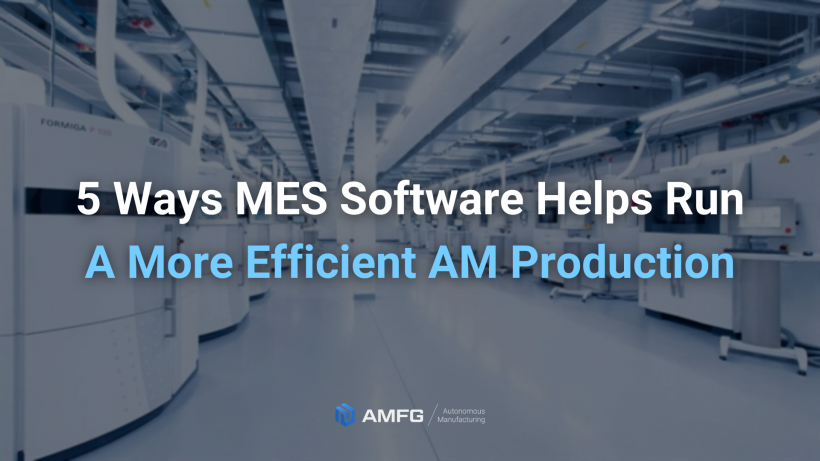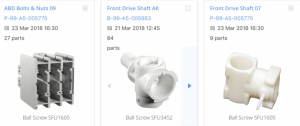The success of your AM production is riding on your manufacturing execution. That’s why it’s crucial to adopt best practices and tools to help you maximise efficiency and value of your AM operations.
Manufacturing Execution System (MES) software, designed for additive manufacturing (AM), is a crucial piece of this puzzle. Additive MES software makes AM production workflows more efficient by synchronising data between systems and coordinating tasks between people.
We’ve put together a list of five ways of how leveraging technology, like MES software, can help you achieve transparent, scalable and intelligent production with AM.
Discover our whitepaper Additive Manufacturing MES Software: The Essential Guide to learn more about Additive MES software.
1. Remove silos to streamline manual tasks
Many companies adopting AM still enter data manually or share work instructions on paper. However, when using AM for production, tools like spreadsheets, paper and back-and-forth email prove inadequate to deal with an increase in production volumes and demands.

Think for a moment – can spreadsheets answer questions like ‘what’s the current status of the project?’, ‘how much does this 3D-printed part cost to produce?’ or ‘which machines are currently printing?’. They can’t because there are only a few things a spreadsheet can give insight to.
So, when a spreadsheet becomes your barrier to getting things done or moving quickly to the heart of the problem, you should think of another way to work through which you can improve the efficiency of your AM facility.
Additive MES software replaces the fragmented systems to connect the shop floor to the rest of your organisation. With such a solution in place, you can automate key stages of the workflow that were previously done manually.
This means your team will no longer need to schedule AM production using spreadsheets or track the progress of builds by manually checking the machine status. Instead, you can establish a centralised platform, where you’ll be able to track projects in real-time, prioritise 3D printing jobs and plan and schedule production accordingly.
Automating your AM production workflow with software helps significantly in saving time, both by avoiding manual error-prone practices and by establishing new processes geared towards growth and performance improvement.
2. Dig into data to make decisions based on facts
You can’t fix what you can’t measure. The efficiency of your AM production is a vague concept until it’s translated into numbers. And yet, you’ve probably come to a point where data is overflowing and scattered all over the place.
From 3D printers and materials to different software systems (ERP, PLM), the data is generated at every stage of AM production. Capturing this data can be challenging, not least because of disconnected systems and manual processes, which don’t allow for real-time access to data.
One way to establish a real-time stream of relevant AM data is through the use of specialised software, like Additive MES. Such software helps to link your machines, other software systems like ERP, PLM and even suppliers, to ensure a continuous, real-time transfer of data at every stage of production.
However, it’s one thing to connect your AM production and operation systems so that they can communicate with each other and provide you with relevant data. It’s another thing to be able to act on that data to drive improvement initiatives.
Additive MES software, powered by analytics capabilities, can help you use the data to identify and solve hidden inefficiencies. For example, Additive MES software allows you to track and document KPIs related to Overall Equipment Efficiency (OEE), such as machine usage, production output and availability.

[Image credit: AMFG]
The data, coupled with real-time analytics, can help you make immediate adjustments where necessary, enabling you to establish operational excellence.
3. Achieve operational visibility across multiple locations
Having thorough visibility into your AM operations is a must when seeking to enhance efficiency and eliminate bottlenecks.
However, experience will tell you that using inadequate planning tools and not having a clear overview of your machine status won’t get your company very far.
This is a particular bottleneck when you’re running operations in different locations and lack that visibility.
Companies must have visibility on information like what has been ordered, by whom and in what time period, as well as the different steps that are required for production, how to schedule and so on, explains AM consultant, Timm Kragl.
Managing multiple worksites comes with its own set of challenges, including the risk of inconsistency and miscommunication.
To avoid these risks, connected workflows allow you to track progress from anywhere. Plus, they allow you to keep operations uniform across multiple sites.
Additive MES helps to establish connected operations, by tracking and documenting data throughout the production workflow and enabling stakeholders to access key information at any stage of the process. It also allows you to track the status of jobs in real-time, which in turn allows for the optimisation of production planning and, ultimately, greater productivity.
4. Enhance communication and team collaboration
Teams need to talk. Having a tool that allows them to collaborate virtually and provide project updates ensures there are no misinterpretations of the work at hand.
MES software for 3D printing offers communication features that let project participants comment on files and receive email notifications of project updates.
In addition to team communication, you can also improve the way your AM team communicates with other departments through email synchronisation.
Integrating MES software with your email service, like Gmail and Outlook, enables you to receive orders and create job tickets directly from a single platform. In practice, it facilitates the shift from spreadsheets and inboxes to a centralised MES software, which simplifies external communication and speeds up the time your team needs to process orders.
Maintaining constant communication, within the team and with other stakeholders, will reduce errors and production delays.
Even if your AM production is spread out across different sites, MES software allows you to keep all communication together in one place, which means nothing gets lost and everyone on the team knows what’s going on at a glance in any given moment.
5. Enforce standardised processes for continuous improvement
Standardising manufacturing and operational processes is vital for the success of production with 3D printing. Without standardised practices in place, your workflow can quickly become inefficient.
For example, without a standardised way for internal teams to receive orders from other areas of the business, the ordering process becomes incredibly time-consuming, with endless emails typically becoming the norm.
For manufacturers operating from multiple sites and in multiple locations, standardised processes offer economies of scale and significant cost-savings.
However, successfully standardising AM processes is often easier said than done. Additive MES software addresses this by providing a centralised way to manage operations across multiple sites.
It helps to enforce a standardised management process that can be deployed multi-nationally. Taking the example above, a standardised interface for ordering optimises the order management process and facilitates better communication between stakeholders.
Additive MES software is the foundation for establishing a standardised additive manufacturing process. A robust Additive MES platform can easily be rolled out across your company, establishing a set of procedures and best practice processes to ensure operational efficiency and continuous improvement.
Boost efficiency of your AM production with Additive MES software
Managing AM production is, in and of itself, an arduous task. But taking full advantage of the digital tools can make this task significantly easier.
MES software, designed to meet the unique needs of additive manufacturing, boosts the efficiency of your processes and your team. It helps to move from spreadsheets and inboxes to a single platform that provides full transparency, accountability and insights you need to drive productivity improvements.
Looking at the bigger picture, a robust Additive MES software links your AM production with the rest of your organisation, removing silos on the way to a fully digitised, standardised and scalable AM operations.



